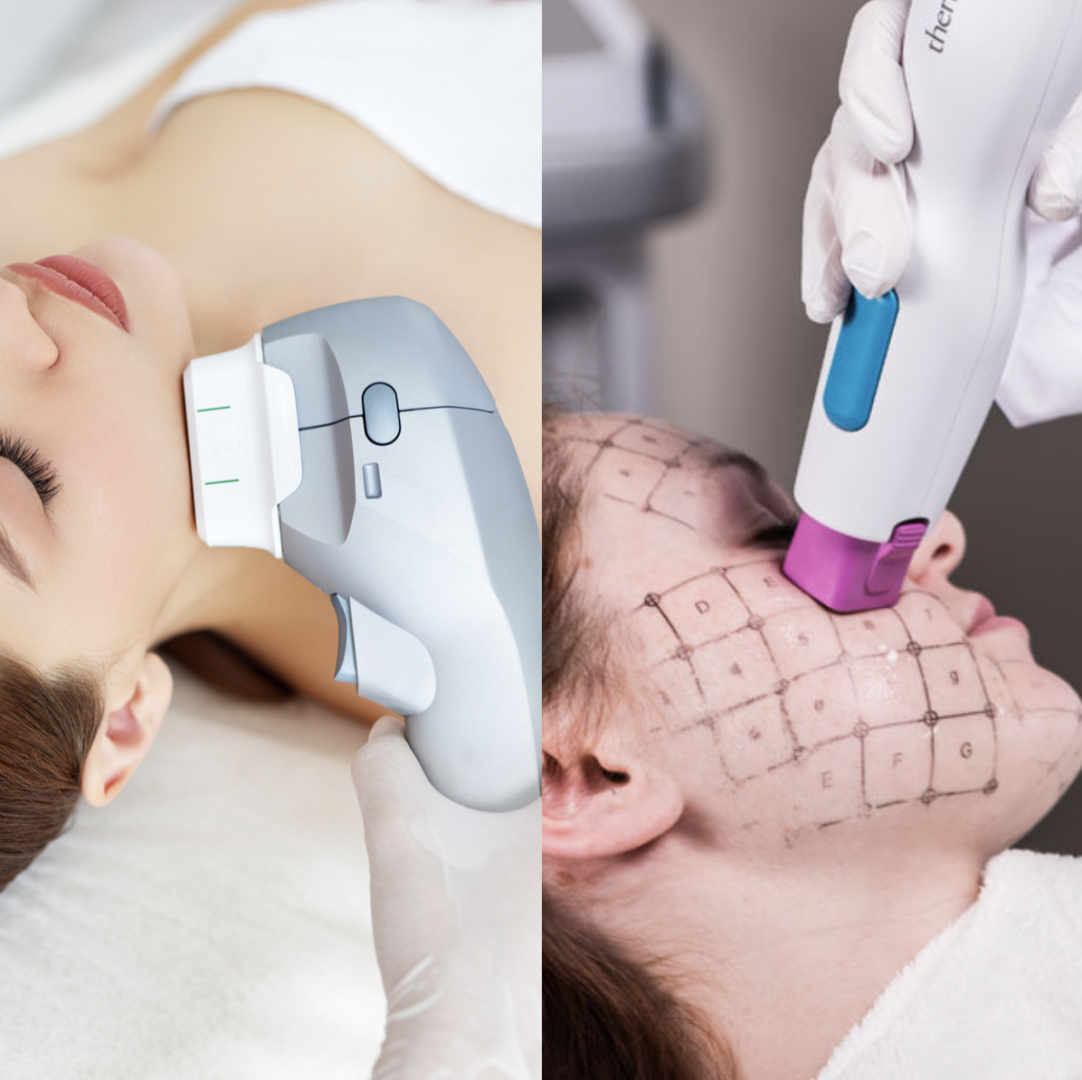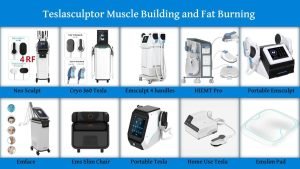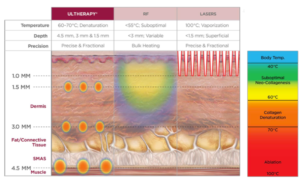Deciding between Thermage and HIFU for a non-surgical skin tightening treatment? This comprehensive guide breaks down the key differences between these two popular collagen remodeling technologies. Thermage uses radiofrequency to temporarily tighten existing collagen, while HIFU rebuilds it with focused ultrasound for longer-lasting results at a higher cost. Discover which best suits your needs and budget based on their unique mechanisms of action, treatment areas, results, safety, and pricing. By the end, you’ll feel confident choosing the ideal solution – a quicker, more affordable fix with Thermage or a dramatic, longer-term rejuvenation with HIFU.

Thermage and Ultrasound hifu both claim to have skin tightening and lifting effects.
In fact, due to differences in the principle of action and layers, Thermage has a stronger skin tightening effect than Ultrasound, while the lifting effect of hifu is stronger than Thermage.
This article will give you a detailed introduction to the working principle, indications, usage, contraindications and precautions of micro-focused ultrasound (HIFU) .
Ulthera is an instrument certified by the US FDA for ” Lift ” lifting indications . It can accurately act on the SMAS fascia layer that can only be treated during facelift surgery . It can be used to target various muscle age problems with machine probes of different depths. Individualized treatment to solve the problems of patients with skin sagging.
The cartridges are mainly divided into three depths: 1.5 , 3.0 , and 4.5mm ( the two treatment heads of 3.0 and 4.5mm are mainly used in China ) . It is equipped with a patented real-time ultrasound imaging system to help doctors monitor the treatment through synchronized ultrasound images during treatment. Depth to ensure safety and accuracy.
The scientific name of the ultrasonic scalpel of the American company Ulthra is microfocused ultrasound (MFU) . Foreign literature is confusing when using the abbreviation of this technology. Sometimes HIFU (high-energy focused ultrasound) and MFU are used interchangeably.
In most cases, MFU specifically refers to the micro-focused ultrasound technology with ultrasound image guidance developed by Ulthrea , while HIFU refers to the focused ultrasound beauty equipment without ultrasound image guidance produced by other companies .

How does HIFU work?
HIFU can focus high-frequency ultrasound beams at specific parts, inducing molecular vibrations to generate heat energy, forming discrete wedge-shaped thermal injury zones with a volume of approximately 1 mm3 from the deep dermis to the SMAS (superficial musculoaponeurotic system) layer . TIZ).
Also known as Thermal Coagulation Points (TCPs), they extend to 3.0-4.5 mm under the epidermis, with an interval of about 1.5 mm.
Induces wound repair response and promotes collagen and elastin regeneration. The superficial dermis (papillary layer) and epidermis are not affected .

The principle of HIFU is to focus high-intensity focused ultrasonic, allowing the subcutaneous temperature to reach 60°C-70°C ,causing collagen to denature and shrink,thereby tightening the deep dermis and fascia layer and stimulating collagen. Protein regeneration changes the original collagen fiber network, thereby lifting and tightening the skin and improving sagging problems.
During this process, the dermis produces a steady stream of collagen to support the skin, while the aging SMAS fascia layer is lifted due to the enrichment of collagen , and the skin regains its elasticity.

The mechanism of action of ultrasonic scalpel includes two stages:
The first stage : the process of collagen denaturation and contraction mentioned earlier .
The second stage is the wound repair stage caused by heat loss , which is divided into the inflammation stage, the proliferative stage, and the maturation and remodeling stage.
inflammatory phase
proliferative phase
This phase may overlap with inflammation, which occurs hours after treatment and usually manifests itself as the synthesis of new collagen (mainly type III) by fibroblasts and other mediators important for rebuilding the collagen matrix, such as elastin and fibronectin. , glycosaminoglycans and proteases.

Maturity and Remodeling Period
This stage usually begins at 3 weeks and can last up to a year . This stage is when type III collagen is replaced by type I collagen, which forms tight cross-links with itself and other proteins. The collagen remodeling process is a critical step in facial skin tightening and lifting.
Treatment depth and treatment levels
The American version of Ulthera provides three treatment heads with different depths: 1.5 mm, 3 mm and 4.5 mm. The 1.5 mm treatment head acts on the superficial dermis and can be used in areas with thin skin such as eyelids.
The 3 mm treatment head acts on the deep dermis, while the 4.5 mm treatment head acts on the SMAS fascial layer .

HIFU scribing design and danger zone
Doctors who have operated ultrasonic scalpels know that since ultrasonic scalpels have the risk of damaging nerves , they must first mark the operating area to avoid dangerous areas where nerves are easily damaged.
The officially recommended line design is as shown below. The detailed marking method will not be described here. If necessary, a special article can be written to introduce it.

Note: The red color in the picture is a restricted area
Operating restricted area (danger zone)
The thermal damage caused by ultrasonic scalpel is generally transmitted only at the level of the SMAS layer, and the average depth of the facial nerve is usually deeper than the SMAS fascial layer . However, the distribution of the temporal branch of the facial nerve, the marginal branch of the mandible, and the supraorbital nerve are superficial and susceptible to damage. Therefore, the corresponding facial area is restricted for operation.
Additionally, all anti-aging devices that penetrate deeply should avoid the thyroid area .
Physicians should strictly follow the line design of the operation manual and are not allowed to operate in restricted areas.
Indications
1. Eyebrow lift
2. Relaxed chin lift
3. Improve fine lines and wrinkles on the chest
4. Neck tissue lifting ( those with BMI>30 are less effective ).
HIFU Contraindications

Unlike HIFU, Thermage uses radiofrequency (RF) energy instead of ultrasound energy to heat and tighten the collagen fibers in the skin. While both technologies aim to achieve skin tightening and rejuvenation, HIFU offers more precise and focused energy delivery, allowing for deeper penetration and targeting of specific tissue layers. Additionally, HIFU typically requires fewer treatment sessions compared to Thermage.
In summary, while Thermage and HIFU share some similarities in their goals, they operate on different principles and have varying levels of precision, depth penetration, and treatment requirements. HIFU is generally considered to be a more advanced and targeted technology for non-invasive skin tightening and rejuvenation procedures.







